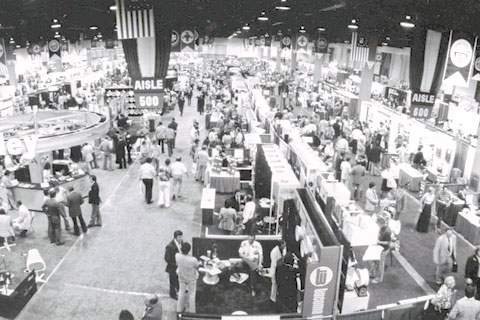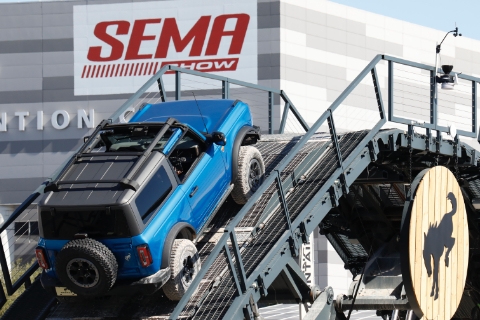SEMA News—July 2011
A Few Words With Paul “Scooter” Brothers
An Interview With the New Chairman of the SEMA Board of Directors
 |
|
Racing Head Service began producing crate engines in the mid-’80s, putting them together at a pace of 2,500 per year and becoming the first mail-order engine supplier that Brothers is aware of. His responsibilities shifted when Brothers moved from Racing Head Service to its sister company, Competition Cams, in the late ’80s. Brothers has been with what has become the Comp Performance Group ever since.
He began his involvement with SEMA in the mid-’90s, beginning with the Motorsports Parts Manufacturers Council (MPMC) and then the very early stages of the SEMA Technology Transfer Program. He has since worked with numerous task forces and councils as well as served on the association’s Board of Directors and, for the past two years, as its chairman-elect.
Brothers said that he was given his nickname when he was a newborn. A hospital staff member observed him trying to “scoot” across his bassinet in the post-delivery room. He has been on the move ever since. He will take his place as the chairman of the SEMA Board of Directors in July, and SEMA News recently interviewed him about his goals and priorities.
SEMA News: What led you to get actively involved with SEMA’s Scholarship Committee?
Paul “Scooter” Brothers: As I’ve gotten older and realized I wasn’t going to be here forever, I took a hard look at the new generation. I quickly found that these were some really bright young people and that our challenge would be to get them into our industry at the earliest age possible. I began working with some schools and with SEMA, and it went from there. SEMA’s work with students is one of the first things that caught my eye. I knew we had an obligation to somehow reach out to the youngsters at the earliest age and show them the benefits of our industry. These are the people who will carry the industry into the next generation, and with SEMA’s help, they will already be well connected when they enter the industry. It may be somewhat self-serving, but my connection to students, interns at the SEMA Show and young people in general has been very rewarding.
SN: Ten years ago, your work with SEMA’s MPMC led to your work in the early development of SEMA’s Technology Transfer Program. A decade later, what do you think about the evolution of the program? What advice do you give to SEMA members who have never taken advantage of Tech Transfer?
PSB: Being a racer, it was easy to enter the council network as a member of the MPMC. I soon began to realize that SEMA offered its members much more than a council to discuss racing. As an engineering guy, I always point to the Technology Transfer Program. It is a direct link between the original-equipment manufacturers [OEM] and SEMA-member companies. It allows companies such as mine to apply for the original factory CAD [computer-aided design] model of the part we are designing. In the past, we had to completely reverse engineer the factory part before we could begin to design our part, so this program really shortcuts the process for SEMA-member companies, and it helps ensure that the part fits properly, which also benefits the car manufacturers and consumers. As vehicles become ever more complex, it’s necessary to work with the OEMs to interface our products with the sophisticated platforms of today.
I can’t tell you how much this program has saved my company in terms of both time and money, so I strongly suggest that any company looking to design parts from the ground up become familiar with it and use it to the fullest.
SN: You traveled to China last year as part of the SEMA CIAPE China Business Development Conference in Beijing. What were your impressions of the specialty-equipment industry in China?
PSB: One thing is for sure: The world is getting much smaller. The more mature our customer base becomes in the United States, it is easy to see that our industry must look for business in other places. As new parts of the world develop, new markets come into SEMA members’ world. China is one of those emerging markets, and it is moving rapidly.

I have traveled to China several times and have watched the people there fall in love with their cars, much like we did in this country as this industry began. These people and this market are going to develop almost instantly, and those SEMA-member companies that are ready will do well there. Any business with an opportunity to learn a new market—especially one as large as China—should do so. SEMA offers a good way to do it.
SN: What are you hearing from colleagues and fellow SEMA members about their balance sheets for the first six months of 2011?
PSB: I try to interface as much as possible with the whole chain of customers, from manufacturer to consumer. From street cars to the most professional racer, it seems that parts are moving pretty well. Once the consumer begins to order parts, someone has to make them and someone has to warehouse them. As far as I can see, things look pretty good for 2011.
SN: With the 2011 SEMA Show roughly four months away, what should SEMA members take advantage of today in order to get the biggest return on their investment?
PSB: Be prepared. Put the finishing touches on new products. Make sure they are ready to deliver, and present them properly. The SEMA Show is about what’s new as well as developing and maintaining relationships between manufacturers and buyers. Everyone in the supply chain must be prepared to make the best of their time at the Show.
SN: SEMA maintains an office in Washington, D.C., to handle legislative and regulatory issues affecting the specialty-equipment industry. What recent victories and/or current legislative struggles are on your radar from the D.C. office?
PSB: A couple of things come to mind right away. One has to do with ever-tightening federal and state emissions standards. SEMA just worked to have what’s called the “Project Green Rod” engine package approved in California for street and specialty vehicles. This means that all of the cars that the SEMA industry loves that are not up to today’s tough standards have a way to comply with the emissions requirements. Another also involves California and its attempt to outlaw all improperly registered specialty vehicles and street rods. Through SEMA’s efforts, there is now a procedure for that to be done.
That doesn’t even touch on all of the work SEMA’s D.C. staff does every day with our federal and state legislators. It’s tough to stay abreast of new regulations, but these people seem to be able to guide SEMA members through it.
SN: What do SEMA members who love the association tell you is the number-one benefit SEMA provides?
PSB: Tough question. There are so many programs that benefit the various segments of the industry that it’s hard to say. For manufacturers, Technology Transfer, the regulation and legislation work and the MPMC are great programs. For the distribution segment, the SEMA Show and market research come to mind.
SN: What are a couple of significant current initiatives?
PSB: SEMA is a members’ association. Two of the programs it is currently working on are education at every level as well as a common, industry-wide platform to develop and distribute product attributes, such as part numbers and descriptions.
SN: What types of business challenges is SEMA helping its membership overcome?
PSB: Emissions and CAFE [Corporate Average Fuel Economy] regulations get tougher every year. Also, the evolution of technology and the complexity of new vehicles have made it very difficult for SEMA-member companies’ products to interface with the OEM platforms. SEMA maintains staff in Detroit to develop and strengthen the link between its members and the OEMs to help overcome this challenge. This list will change as the challenges evolve.
SN: What do you see as the association’s top priorities over the next 12 months?
PSB: I believe that SEMA should deliver world-class market research to its members to help them plan for the future. Staying abreast of changes in technology and regulations will continue to be an issue. And, of course, the association must continue to serve the needs of its members as well as the market and the industry. An important example is SEMA’s Education Institute offering a wide range of business-oriented seminars and webinars, many of which are recorded and available on the SEMA website.
SN: You recently participated in a panel discussion at the 2011 Global Automotive Aftermarket Symposium entitled “The Business Side of Racing.” What were the biggest takeaways from that discussion that everyone doing business in motorsports needs to understand?
PSB: Many companies participate one way or another in motorsports. Many have no idea how to make this involvement help them sell more product. One of my messages was for them to visit the SEMA Show and get a flavor of the industry.
SN: RHS began doing mail-order business when you worked for the company in the ’70s. By the mid-’80s, you were shipping about 2,500 engines a year. What advice can you offer to companies hoping for similar success using Internet retailing?
PSB: Stick with it, listen to the customer and don’t forget the difference between cash flow and profit. It’s very easy to have a pocket full of money and think you are making a profit. That’s what gets a lot of new businesses in trouble.








